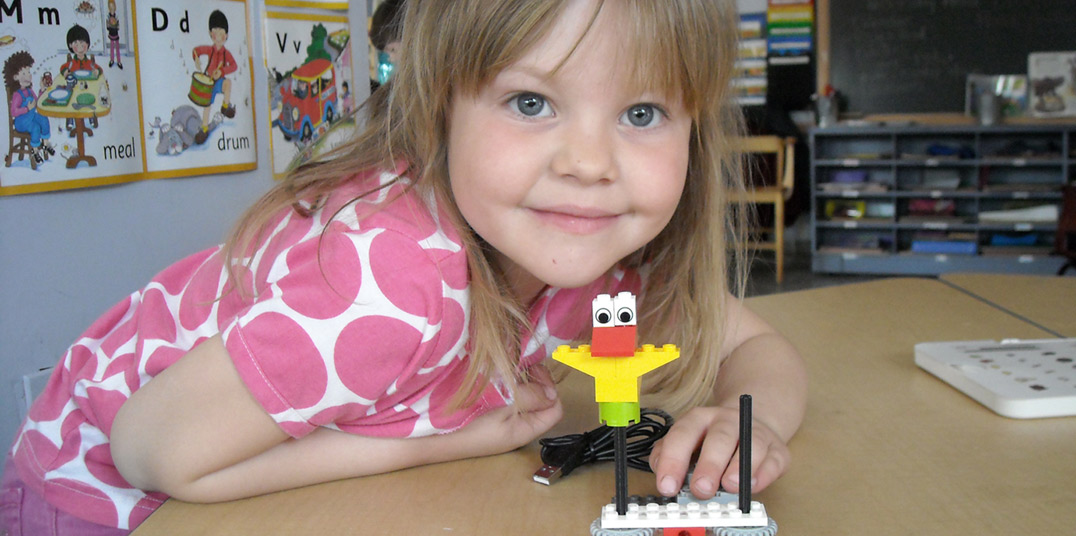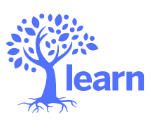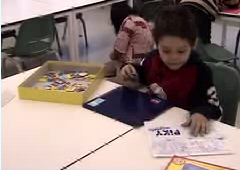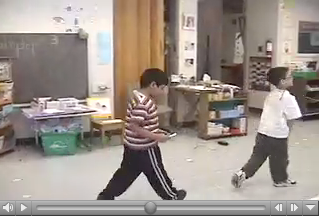Robotics in Kindergarten

Before You Start - Laying the Groundwork
Starting early on in the year, there are things you can do to lay the groundwork for implementing robotics. Closer to project time, the children should become familiar with robots through play-based preparation activities which will allow them express their initial perceptions and understanding about robots as well as develop skills later required for building and programming.
Links to the Preschool Education program Download ![]()
Six graphic organisers Download ![]()
Use them throughout the project in a variety of contexts. My research organiser; Making predictions; This is how I did it (4 steps); This is how I did it (6 steps); Reflecting on Robotics; My reflection.
Learning to read plans
An important skill
Reading plans is a skill the students need to learn through prior practice. It is a skill closely connected to reading, so the one reinforces the other. Among other things, it reinforces reading from left to right and from top to bottom.
Games involving plans
Some examples of games that teach the children to read plans, locate symbols, reproduce visual instructions and build according to them.
A list of games that involve plans
Download![]()
The gears that connect it
WeDo robots move thanks to a variety of gear systems that connect the motor to the moving parts. Here are 2 examples of activities that allow the children to discover how gears can be connected and to be attentive to their presence and roles in their robots.
List of Gear Games
Download![]()
Creating an information wall
To introduce robots and what they are, the children focused on researching through non-fiction reading. They showed what they learned by creating an information wall that was posted outside the class. Then they invited other classes and they explained it.
See also, in French:
Chanter et réciter des comptines Go to site![]()
Robotics on the Service national du RÉCIT à l’éducation préscolaire
More on documentary reading in Preschool Go to page![]()
Discovering the characteristics of a robot and of programming
These activities can be part of your warm-up and hook activities. The objective here is to help the children express their current understanding and to create opportunities for discussions and Aha! moments.
What is a robot? Download![]()
Information document for teachers
Wondering- What are robots, really?
In constructing their understanding of the world, the children make associations with what they already know. (1m 22 sec)
Is it a robot or not?
Animate a discussion to bring out the children’s conceptions. The set of "Robots-not robots" signs as well as the images for sorting can be used with or without a white board.
Robot-not robot sorting signs Download![]()
Robot-not robot images for sorting Download![]()
Understanding programming through play
Using a cardboard game console, a student instructs a fellow robot to move in the classroom. The game initiates students to the concept of programming and of the importance of each instruction given.
Get the Game Console
Download![]()
See also in French:
Découvrir les caractéristiques d’un robot Go to site![]()
Robotics on the Service national du RÉCIT à l’éducation préscolaire
Building WeDo Robots
The Wedo Plans
LEGO WeDo offers a series of plans that were modified by the RÉCIT national à l'éducation préscolaire to adappt them to the kindergarrten context. They were translated by Learn.
- Plan 1: Dancing Birds Download

- Plan 2: Smart Spinner Download

- Plan 3: Drumming Monkey Download

- Plan 4: Hungry Alligator Download

- Plan 5: Roaring Lion Download

- Plan 6: Flying Bird Download

- Plan 7: Goal Kicker Download

- Plan 8: The Goal Keeper Download

- Plan 9: Cheerful Fans Download

- Plan 10: Airplane Rescue Download

- Plan 11: Giant Escape Download

- Plan 12: Sailboat Storm Download

The Wedo Pieces
Use these resources in a variety of contexts to help the childrem become familiar with the parts, their names and fucntions. Create games and playful activities around them.
- Lexicon of part names Download

- Beams Download

- Bricks Download

- Electric pieces Download

- Other pieces Download

Some Management Ideas
Learning about the pieces
Students learn about the pieces, what they look like and what they are called. Then they set up for building the robot. (1 m 45 sec)
Time to Build
In this video, the first model, Dancing Birds, is introduced and the building begins. A teacher shares her management strategy for this phase of the project. (1m 51 sec)
See also in French:
Deux petites activités à réaliser avec les pièces LEGO Go to site ![]()
(Service national du RÉCIT à l’éducation préscolaire )
Programming WeDo Robots
After having learned what the programming icons do and how to create short programming “sentences”, (use IWB and other strategies) provide the children with these simple programming challenges. Help them think out loud about their solutions by asking questions to help them problem solve. The answers sheets are for your eyes only! They are not meant for the students to use as a set of instructions to follow.
The programming challenges
- Challenge1: Dancing Birds Download

- Challenge 2: Smart Spinner Download

- Challenge 3: Drumming Monkey Download

- Challenge 4: Hungry Alligator Download

- Challenge 5: Roaring Lion Download

- Challenge 6: Flying Bird Download

- Challenge 7: Goal Kicker Download

- Challenge 8: The Goal Keeper Download

- Challenge 9: Cheerful Fans Download

- Challenge 10: Airplane Rescue Download

- Challenge 11: Giant Escape Download

- Challenge 12: Sailboat Storm Download

Related support materials
- The vocabulary of the WeDo programming icons Download

- Programming icons pictograms (small) Download

- Programming icons pictograms (large) Download

Cut them out and plasticise. The children can use them to plan out and discuss their solution to each programming challenge, then test it on the computer. Crreate a game, such a a matching game, to help them learn the vocabulary associated with the icons. - The backgrounds and their associated number Download

- The sounds and their associated number Download

Some management ideas
Shared Practices: Videos
Contexts for observing learning
While this project is about robots, its role is to provide a rich variety of contexts for the children to participate actively in their learning. Observation will be the favoured means of evaluation. Here are some examples of contexts that set the scene for observing the children’s attitudes, behaviours, processes, strategies and productions. You’ll find that several things always happen simultaneously that can be connected to more than one competency or area of development.
Working with Centers
Claude Poulin describes some of the centers she put in place as part of the learning situation and as a way to manage her class (51 sec)Reflect and communicate
A free play robot-building activity followed by a 4-step visual representation/reflection on the process and communication. Cycle 1 students. (48 sec)
Sorting
Learning related to cognitive development: grouping and sorting games. The students develop the sorting categories as they work in teams, Cycle 1 students. (2 m 29 sec)Programming the robot
After having programmed the basic challenges, the students quickly move to develop their own. They discover and express their personal understanding of the programming elements. Cycle 1 students. (1 m 48 sec)
Robotics Portofolio Tools
Portfolio Reflection Organizers
- This is how I did it (4)
- This is how I did it (6)
- My research organiser
- Making predictions
- Reflecting on robotics
- I am proud of myself
- My reflection
Get the collection in .zip format Download




 FACEBOOK
FACEBOOK TWITTER
TWITTER
 INSTAGRAM
INSTAGRAM LINKEDIN
LINKEDIN